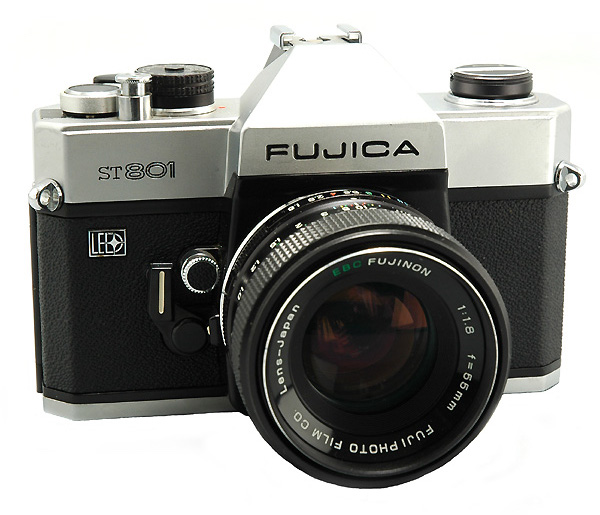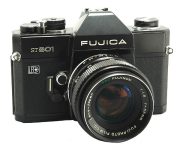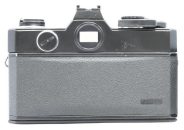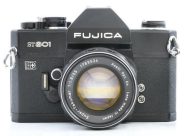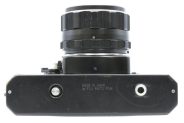Announced
Production status
System
Fujica ST801
35mm MF film SLR camera • Discontinued
Specification
| Format: | |
| 35mm full frame | |
Film type: | 135 cartridge-loaded film |
| M42 [45.5mm] | |
| Shutter: | |
Type: | Focal-plane |
Model: | Mechanical |
Speeds: | 1 - 1/2000 + B |
| Exposure: | |
Exposure metering: | Through-the-lens (TTL), open-aperture |
Exposure modes: | Manual |
| Physical characteristics: | |
Weight: | 830g |
Dimensions: | 133x91x88mm |
Manufacturer description #1
LED (Light Emitting Diodes) Needle-less Metering System, Through-The-Lens Full Aperture Averaging Silver Battery Meter with Silicon Photocells.
The light is measured by Silicon photocells, which react to light tens of times faster and more accurate than conventional CdS photocells.
Exposure is indicated by seven light-emitting diodes in the viewfinder instead of the usual meter needle. The diode light can be moved several steps above normal exposure or below when special exposure effects are desired. Since the light energy reflected from the subject is converted directly into electrical energy in the form of diode light and no mechanical mechanism is used, the exposure indication is quick and meter deviation caused by shocj or mechanical failure is eliminated.
FUJINON EBC (ELectron Beam Coating) Lens
The key elements of each of the ST801's interchangeable lenses are coated with 11 layers to assure complete protection against flare and ghost images as well as producing the ultimate in color definition and picture sharpness.
The FUJICA ST801 Complete Photographic System
A wide selection of interchangeable lenses ranging all the way from 28mm wideangle to 1000mm ultratelephoto plus two zoom lenses and a complete set of carefully engineered accessories bring every picture-taking situation within easy reach of everyone.
***
Type: 35mm, single-lens reflex camera.
Picture Size: 24x36mm
Standard Lens: EBC Fujinon 1:1.8 55mm; 4 components, 6 elements; EBC Fujinon 1:1.4 50mm; 6 components, 7 elements
Lens Mounting: Screw in type (Praktica mount). Mounting location locking device.
Shutter: Focal-plane; B-1-1/2000 sec.; FP and X contacts; built-in self-timer; Hot Shoe; safety lock equipped switch-on switch-off shutter release button.
Viewfinder: Pentaprism with Fresnel lens; 0.96x magnification with F1.8 55mm lens; 2-way focusing with microprism and split-image, exposure control light emitting diodes (7) and shutter speed visible in viewfinder.
Mirror: Quick return type.
Exposure Meter: TTL silicon photocell and light emitting diode metering system, averaging light measurement through full aperture and stopped-down aperture, aperture and shutter speed interlocked with exposure meter, switch-on switch-off with shutter release button, built-in large scale integrated circuit
Meter Range: EV1 to 19; operates with ASA film speeds 25 to 3,200 (1/3rd step).
Power Source: One 6V silver battery (Mallory PX28, Eveready 544).
Film Advance: Single-stroke lever action; 193 deg. winding angle, winding latitude provided by lever top, returnable lever (from any winding position), self-cocking shutter, easy loading, provision for double-exposure prevention, automatic reset frame counter.
Film Rewind: Crank.
Manufacturer description #2
Instead of the conventional CdS meter, the ST-801 continues Fuji's pioneering use of the revolutionary SILICON photocell. It allows the ST-801 to respond to light variations 10 times faster.
Instead of an electro-mechanical system, the ST-801 has SOLlD·STATE READOUT with seven light-emitting diodes (LED's), you'll see the very instant you look through the viewfinder.
Try the "DARK CORNER TEST" right now: Focus on any dark area in the store, see the bright red LED's lighting up inside the viewfinder as they respond to light variations - or the changes YOU make in f/stop or shutterspeed. Note the surprising CLARITY and BRILLlANCE of the image in the viewfinder... then judge for yourself.
Each one of these diodes, which can be seen as clearly in the dark as in the brightest sunlight, represents the difference of one f/stop from the next consecutive diode, the center diode indicating the correct exposure. If two adjacent diodes are visible at the same time, this indicates an intermediate exposure. This SOLlD-STATE readout allows you to freely and accurately CONTROL the over- or under-exposure of your picture. In addition, the fragile meter-movement, as well as the needle, are replaced by LED's and all solid-state electronics: no moving parts! Extra protection is therefore provided against meter deviations due to concussion, dust or mechanical failure.
1. FULL APERTURE METERING
No matter at what f/stop the aperture is set, it remains fully open for light-measurement, up to the moment the shutter is released.
2. SILICON PHOTOCELLS
The ST-801's photocells respond to a broader range of the light spectrum faster and more accurately than a conventional CdS cell.
3. FET (FIELD EFFECT TRANSISTOR)
The FET amplifies the light energy from the 2 silicon photocells and transmits it to the computer logic.
4. COMPUTER LOGIC
The LSI (Large Scale Integrated Circuit) of the computer's logic correlates light-intensity reflected by subject-matter with filmspeed, f/stop and shutterspeed, giving precise LED readout.
5. LIGHT EMITTING DIODES (LED's)
LED's, at a glance, show computed exposure, with full option of manual override by the photographer for any desired special effects.
MATCHED SERIES OF ESC FUJINON LENSES
Now the full range of interchangeable lenses, 28mm through 1000mm, has Fuji's multi-layer ELECTRON-BEAM-COATING which cuts flare, improves transmission and color-balance, eliminating ghost images. All feature the exclusive fixed-point, screw-in lockmount for precise seating and alignment. There are nine lenses with this technological breakthrough: 28mm f/3.5; 35mm f/2.8; 50mm f/1.4; 55mm f/1.8; 100mm f/2.8; 135mm f/3.5; 200mm f/4.5; 1000mm f/8 and 75-150mm f/4.5 Zoom. A 54-270mm f/4.5 Zoom to be announced.
Silver coated prism and aluminum mirror
By coating the surfaces of the prism with silver and using an aluminum mirror, 94% of the light passing through the lenses is reflected into the viewfinder.
The result is an unusually bright image. Focusing and checking depth-of-field are simplified even in available tight situations. A more accurate reading of the light by the photo electric cell is also assured.
Master-Control Viewfinder Shows Everything
Since the overall image is 50% brighter, COMPOSITION and FOCUSING are very fast and easy. The microprism in the center practically glows. LED readout of the solid-state electronic meter can be seen as clearly in the dark as in the brightest sunlight! Shutter-speed chosen is visible in the viewfinder, and, by depressing the Aperture-Selector Button, even DEPTH OF FIELD can visually be observed.
Precision 1/2000-sec. Shutter
New hi-efficiency focal-plane shutter with FP and X synchronization, selftimer and speeds from 1-1/2,000 sec. plus B. Never needs oiling, due to a new silicon-sintered alloy (oil-less metal) used in all moving parts. This also assures that accuracy of exposure is maintained throughout a broad temperature range from -4° to 122 deg. F.
From the editor
The weight and dimensions are indicated for the camera body with the Fuji EBC Fujinon 55mm F/1.8 lens mounted.
Similar cameras (158)
35mm full frame • Manual focus • Film • Singe-lens reflex • M42 mount
| Model | Shutter | Metering | Modes | Year |
|---|---|---|---|---|
| Alpa Si 2000 | E, 1/2000 | TTL • WA | AM | 1977 ● |
| Argus CR-3E | E, 1/2000 | TTL • WA | M | ● |
| Argus/Cosina STL 1000 | M, 1/1000 | TTL • WA | M | 1970 ● |
| Asahi Pentax aka Tower 26 |
M, 1/500 | -- | M | 1957 ● |
| Asahi Pentax ES aka Asahi Pentax Electro Spotmatic aka Honeywell Pentax ES |
E, 1/1000 | TTL • OA | AM | 1971 ● |
| Asahi Pentax ES II aka Honeywell Pentax ES II |
E, 1/1000 | TTL • OA | AM | 1973 ● |
| Asahi Pentax K aka Tower 29 |
M, 1/1000 | -- | M | 1958 ● |
| Asahi Pentax S aka Tower 26 |
M, 1/500 | -- | M | 1958 ● |
| Asahi Pentax S1 aka Honeywell Heiland Pentax H-1 aka Honeywell Pentax H1 |
M, 1/500 | -- | M | 1961 ● |
| Asahi Pentax S1a aka Honeywell Heiland Pentax H-1a aka Honeywell Pentax H1a |
M, 1/500 | -- | M | 1962 ● |
| Asahi Pentax S2 aka Honeywell Heiland Pentax H-2 aka Honeywell Pentax H2 |
M, 1/1000 | -- | M | 1959 ● |
| Asahi Pentax S3 aka Honeywell Heiland Pentax H-3 aka Honeywell Pentax H3 |
M, 1/1000 | -- | M | 1961 ● |
| Asahi Pentax Spotmatic aka Honeywell Pentax Spotmatic |
M, 1/1000 | TTL • WA | M | 1964 ● |
| Asahi Pentax Spotmatic F aka Honeywell Pentax Spotmatic F |
M, 1/1000 | TTL • OA | M | 1973 ● |
| Asahi Pentax Spotmatic II | M, 1/1000 | TTL • WA | M | 1971 ● |
| Asahi Pentax Spotmatic SL aka Honeywell Pentax Spotmatic SL |
M, 1/1000 | -- | M | 1968 ● |
| Asahi Pentax Spotmatic SP 1000 aka Honeywell Pentax Spotmatic SP 1000 |
M, 1/1000 | TTL • WA | M | 1974 ● |
| Asahi Pentax Spotmatic SP 500 aka Honeywell Pentax Spotmatic SP 500 |
M, 1/500 | TTL • WA | M | 1971 ● |
| Asahi Pentax SV aka Honeywell Pentax H3v |
M, 1/1000 | -- | M | 1962 ● |
| Chinon AM-3 | M, 1/1000 | TTL • WA | M | ● |
| Chinon CE II Memotron | E, 1/2000 | TTL • WA | AM | 1975 ● |
| Chinon CE Memotron | E, 1/2000 | TTL • WA | AM | 1973 ● |
| Chinon CE-3 Memotron | E, 1/1000 | TTL • WA | AM | 1977 ● |
| Chinon CM-1 | M, 1/1000 | TTL • WA | M | ● |
| Chinon CM-3 | M, 1/1000 | TTL • WA | M | 1977 ● |
| Chinon CS | M, 1/1000 | TTL • WA | M | 1976 ● |
| Chinon CS-4 | M, 1/1000 | TTL • WA | M | ● |
| Chinon CX | M, 1/1000 | TTL • WA | M | ● |
| Chinon CX II | M, 1/1000 | TTL • WA | M | 1976 ● |
| Chinon LED Promaster | M, 1/1000 | TTL • WA | M | ● |
| Chinon M-1 | M, 1/1000 | TTL • WA | M | 1973 ● |
| Chinon SLR | M, 1/1000 | TTL • WA | M | 1979 ● |
| Chinonflex TTL | M, 1/1000 | TTL • WA | M | ● |
| Contax D aka ConSol aka HEXACON aka Pentacon |
M, 1/1000 | -- | M | 1951 ● |
| Contax E aka Pentacon E |
M, 1/1000 | Window | M | 1956 ● |
| Contax F aka Pentacon F |
M, 1/1000 | -- | M | 1956 ● |
| Contax FB aka Pentacon FB |
M, 1/1000 | Window | M | 1956 ● |
| Contax FBM aka Pentacon FBM |
M, 1/1000 | Window | M | 1958 ● |
| Contax FM aka Pentacon FM |
M, 1/1000 | -- | M | 1958 ● |
| Contax S | M, 1/1000 | -- | M | 1949 ● |
| Cosina 1000S | M, 1/1000 | TTL • WA | M | 1975 ● |
| Cosina 4000S aka Vivitar 400/SL |
M, 1/1000 | TTL • WA | M | 1976 ● |
| Cosina CSL / CSM aka Vivitar XC-3 |
E, 1/1000 | TTL • WA | M | 1977 ● |
| Cosina CSR aka Vivitar XC-2 |
E, 1/1000 | TTL • WA | M | 1976 ● |
| Cosina Hi-Lite | M, 1/1000 | TTL • WA | M | 1968 ● |
| Cosina Hi-Lite 202 aka Vivitar 220/SL |
M, 1/1000 | TTL • WA | M | 1975 ● |
| Cosina Hi-Lite 205 aka Vivitar 250/SL |
M, 1/1000 | TTL • WA | M | 1976 ● |
| Cosina Hi-Lite 402 aka Vivitar 420/SL |
M, 1/1000 | TTL • WA | M | 1975 ● |
| Cosina Hi-Lite 405 aka Vivitar 450/SLD |
M, 1/1000 | TTL • WA | M | 1975 ● |
| Cosina Hi-Lite DL / DLR aka Edixa 2MTL |
M, 1/1000 | TTL • WA | M | 1970 ● |
| Cosina Hi-Lite EC aka Argus/Cosina EC 2000 |
E, 1/2000 | TTL • WA | AM | 1972 ● |
| Cosina Voigtlander Bessaflex TM | M, 1/2000 | TTL • WA | M | 2003 ● |
| Exa 1b aka Exa 1c |
M, 1/175 | -- | M | 1977 ● |
| Exakta FE 2000 | M, 1/1000 | TTL • OA | SM | 1976 ● |
| Exakta TL 1000 | M, 1/1000 | TTL • WA | M | 1976 ● |
| Exakta TL 500 | M, 1/500 | TTL • WA | M | 1975 ● |
| Exakta Twin TL 42 | M, 1/1000 | TTL • WA | M | ● |
| Honeywell Pentax Spotmatic IIa | M, 1/1000 | TTL • WA | M | 1971 ● |
| Mamiya DSX 1000 | M, 1/1000 | TTL • OA | M | 1974 ● |
| Mamiya DSX 1000B | M, 1/1000 | TTL • OA | M | 1975 ● |
| Mamiya DSX 500 | M, 1/500 | TTL • OA | M | 1974 ● |
| Mamiya MSX 1000 | M, 1/1000 | TTL • OA | M | 1974 ● |
| Mamiya MSX 500 | M, 1/500 | TTL • OA | M | 1974 ● |
| Mamiya/Sekor 1000 DTL | M, 1/1000 | TTL • WA | M | 1968 ● |
| Mamiya/Sekor 1000 TL | M, 1/1000 | TTL • WA | M | 1966 ● |
| Mamiya/Sekor 2000 DTL | M, 1/2000 | TTL • WA | M | 1969 ● |
| Mamiya/Sekor 500 DTL | M, 1/1000 | TTL • WA | M | 1968 ● |
| Mamiya/Sekor 500 TL | M, 1/500 | TTL • WA | M | 1966 ● |
| Mamiya/Sekor CP aka Mamiya/Sekor CWP |
M, 1/1000 | Window | M | 1964 ● |
| Olympus FTL | M, 1/1000 | TTL • OA | M | 1970 ● |
| Pentacon super | M, 1/2000 | TTL • OA | M | 1968 ● |
| Pentaflex SL | M, 1/500 | -- | M | 1967 ● |
| Petri Penta | M, 1/500 | -- | M | 1959 ● |
| Praktica | M, 1/500 | -- | M | 1949 ● |
| Praktica DTL 2 | M, 1/1000 | TTL • WA | M | 1978 ● |
| Praktica DTL 3 | M, 1/1000 | TTL • WA | M | 1979 ● |
| Praktica EE 2 | E, 1/1000 | TTL • OA | AM | 1977 ● |
| Praktica EE 3 | E, 1/1000 | TTL • OA | AM | 1979 ● |
| Praktica FX aka Praktiflex FX |
M, 1/500 | -- | M | 1952 ● |
| Praktica FX 2 aka Praktica FX 3 |
M, 1/500 | -- | M | 1956 ● |
| Praktica III | M, 1/500 | -- | M | 1955 ● |
| Praktica IV (early) | M, 1/500 | -- | M | 1959 ● |
| Praktica IV (late) | M, 1/500 | -- | M | 1960 ● |
| Praktica IV B | M, 1/500 | Window | M | 1961 ● |
| Praktica IV BM | M, 1/500 | Window | M | 1961 ● |
| Praktica IV F | M, 1/500 | -- | M | 1963 ● |
| Praktica IV FB | M, 1/500 | Window | M | 1963 ● |
| Praktica IV M | M, 1/500 | -- | M | 1961 ● |
| Praktica L aka Praktica autoreflex S |
M, 1/1000 | -- | M | 1969 ● |
| Praktica L 2 | M, 1/1000 | -- | M | 1975 ● |
| Praktica LB aka Praktica autoreflex SL |
M, 1/1000 | Window | M | 1972 ● |
| Praktica LB 2 | M, 1/1000 | Window | M | 1976 ● |
| Praktica LLC | M, 1/1000 | TTL • OA | M | 1969 ● |
| Praktica LTL aka Praktica autoreflex S-TL |
M, 1/1000 | TTL • WA | M | 1970 ● |
| Praktica LTL 2 | M, 1/1000 | TTL • WA | M | 1975 ● |
| Praktica LTL 3 | M, 1/1000 | TTL • WA | M | 1975 ● |
| Praktica mat | M, 1/1000 | TTL • WA | M | 1965 ● |
| Praktica MTL 3 | M, 1/1000 | TTL • WA | M | 1978 ● |
| Praktica MTL 5 | M, 1/1000 | TTL • WA | M | 1983 ● |
| Praktica MTL 50 | M, 1/1000 | TTL • WA | M | 1985 ● |
| Praktica MTL 5B aka Praktica MTL NOVA B aka Praktica TL 5B |
M, 1/1000 | TTL • WA | M | 1985 ● |
| Praktica nova | M, 1/500 | -- | M | 1964 ● |
| Praktica nova B | M, 1/500 | Window | M | 1965 ● |
| Praktica PL electronic | E, 1/500 | -- | M | 1967 ● |
| Praktica PL nova I | M, 1/500 | -- | M | 1967 ● |
| Praktica PL nova IB | M, 1/500 | Window | M | 1967 ● |
| Praktica PLC 2 | M, 1/1000 | TTL • OA | M | 1975 ● |
| Praktica PLC 3 | M, 1/1000 | TTL • OA | M | 1978 ● |
| Praktica super TL | M, 1/500 | TTL • WA | M | 1968 ● |
| Praktica super TL 2 aka Praktica 1000 |
M, 1/500 | TTL • WA | M | 1975 ● |
| Praktica super TL 3 | M, 1/500 | TTL • WA | M | 1978 ● |
| Praktica super TL1000 aka Praktica MTL 3 aka Praktica MTL 5 aka Praktica NOVA II aka Praktica PM 3 aka Praktica TL 3 |
M, 1/1000 | TTL • WA | M | 1980 ● |
| Praktica super TL500 | M, 1/500 | TTL • WA | M | 1981 ● |
| Praktica V F | M, 1/500 | -- | M | 1964 ● |
| Praktica V FB | M, 1/500 | Window | M | 1965 ● |
| Praktica VLC | M, 1/1000 | TTL • OA | M | 1974 ● |
| Praktica VLC 2 | M, 1/1000 | TTL • OA | M | 1976 ● |
| Praktica VLC 3 | M, 1/1000 | TTL • OA | M | 1976 ● |
| Ricoh Auto TLS EE | M, 1/1000 | TTL • OA | SM | 1976 ● |
| Ricoh Singlex II | M, 1/1000 | TTL • WA | M | 1976 ● |
| Ricoh Singlex TLS | M, 1/1000 | TTL • WA | M | 1967 ● |
| Ricoh SLX 500 | M, 1/500 | TTL • WA | M | 1975 ● |
| Ricoh TLS 401 | M, 1/1000 | TTL • WA | M | 1970 ● |
| Sigma Mark-I | M, 1/1000 | TTL • WA | M | 1975 ● |
| Voigtlander VSL1 (TM) aka Ifbaflex M 102 |
M, 1/1000 | TTL • OA | M | 1974 ● |
| Yashica Electro AX | E, 1/1000 | TTL • WA | AM | 1972 ● |
| Yashica FFT | M, 1/1000 | TTL • WA | M | 1973 ● |
| Yashica J-3 | M, 1/500 | Window | M | 1962 ● |
| Yashica J-4 | M, 1/500 | Window | M | 1965 ● |
| Yashica J-5 | M, 1/1000 | Window | M | 1964 ● |
| Yashica J-7 | M, 1/1000 | Window | M | 1966 ● |
| Yashica J-P | M, 1/500 | -- | M | 1964 ● |
| Yashica Penta J aka Yashica Reflex 35 |
M, 1/500 | -- | M | 1961 ● |
| Yashica TL | M, 1/500 | TTL • WA | M | 1968 ● |
| Yashica TL Electro X | E, 1/1000 | TTL • WA | M | 1968 ● |
| Yashica TL Electro X ITS | E, 1/1000 | TTL • WA | M | 1970 ● |
| Yashica TL-E | M, 1/500 | TTL • WA | M | 1969 ● |
| Yashica TL-Electro | M, 1/1000 | TTL • WA | M | 1972 ● |
| Yashica TL-Super | M, 1/1000 | TTL • WA | M | 1966 ● |
| Zeiss Ikon Icarex 35 (TM) | M, 1/1000 | -- | M | 1969 ● |
| Zeiss Ikon Icarex 35S (TM) | M, 1/1000 | TTL • OA | M | 1969 ● |
| Zeiss Ikon SL706 | M, 1/1000 | TTL • OA | M | 1971 ● |
| Zenit-10 aka Зенит-10 |
M, 1/500 | Window | M | 1982 ● |
| Zenit-11 aka Зенит-11 |
M, 1/500 | Window | M | 1982 ● |
| Zenit-122[V] aka Зенит-122[В] |
M, 1/500 | TTL • WA | M | 1990 ● |
| Zenit-12sd aka Zenit-12xp aka Зенит-12сд |
M, 1/500 | TTL • WA | M | 1983 ● |
| Zenit-15M | M, 1/500 | TTL • WA | M | ● |
| Zenit-16 aka Зенит-16 |
M, 1/1000 | TTL • OA | M | 1975 ● |
| Zenit-18 aka Зенит-18 |
E, 1/1000 | TTL • OA | AM | 1980 ● |
| Zenit-19 aka Зенит-19 |
E, 1/1000 | TTL • WA | M | 1979 ● |
| Zenit-312m | M, 1/500 | TTL • WA | M | 1999 ● |
| Zenit-412DX | M, 1/500 | TTL • WA | M | 2000 ● |
| Zenit-412LS | M, 1/500 | TTL • WA | M | 2002 ● |
| Zenit-E aka Зенит-Е |
M, 1/500 | Window | M | 1965 ● |
| Zenit-EM aka Зенит-ЕМ |
M, 1/500 | Window | M | 1972 ● |
| Zenit-ET aka Зенит-ЕТ |
M, 1/500 | Window | M | 1981 ● |
| Zenit-TTL aka Zenit-12 aka Зенит-12 aka Зенит-TTL |
M, 1/500 | TTL • WA | M | 1978 ● |
| Zenit-V aka Зенит-В |
M, 1/500 | -- | M | 1968 ● |
